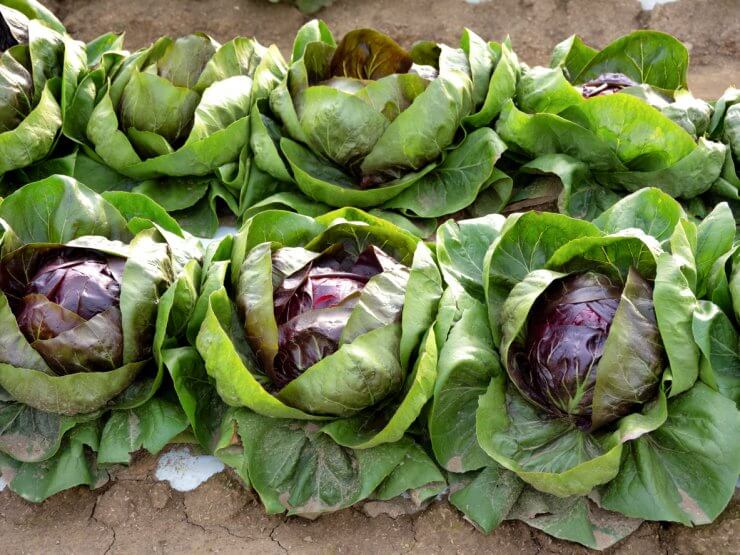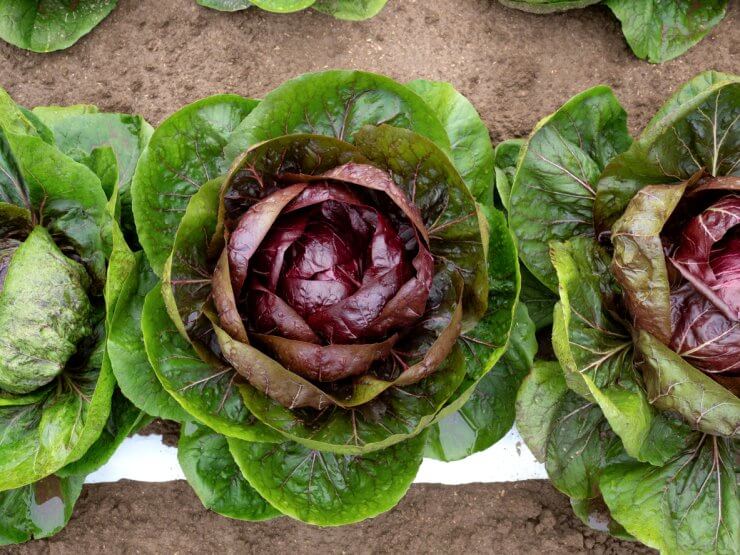
Growing radicchio
Radicchio tends to divide people. To some, it’s a beautiful, scarlet burst in the garden, with leaves that look like they belong in a Renaissance painting. To others, its bitter bite is an acquired taste, better admired than eaten. But whether or not radicchio makes it to your salad bowl, it can still earn a place in the garden. What many don’t realize is that radicchio is more than a crop–it’s a soil ally, a plant whose very growth habit benefits the ground it grows in and sets the stage for healthier harvests down the line.
Breaking Ground with Deep Roots
The secret lies in radicchio’s taproot. Unlike lettuce, which barely skims the surface of the soil, or spinach, which grows quickly and shallowly, radicchio invests in a long, central root that can reach two feet or more when conditions are right. In the Veneto region of Italy, where radicchio has been cultivated for centuries, farmers know this trait well. The root is what allows the plant to survive cool nights, mild frosts, and stretches of unpredictable rain–it anchors the crop and gives it access to water long after shallower-rooted vegetables have wilted.
For gardeners, this means radicchio can do something most greens can’t: it breaks up compacted soil. Compaction is a common problem in raised beds and heavily worked plots. Over time, foot traffic, heavy rains, or repeated tilling press soil particles together until water can’t drain, roots can’t push through, and air can’t circulate. Mechanical solutions–broadforking, double-digging, or even rototilling–may provide temporary relief, but radicchio offers a biological alternative.
As its taproot drives down, it carves through dense layers, leaving behind narrow channels that remain after the plant dies back. These channels improve water infiltration and aeration naturally. Even more importantly, when the root decomposes, it contributes organic matter directly into the subsoil. Over time, this changes the soil structure itself, transforming hardpan into a looser, more friable medium. For anyone looking to reduce the cycle of compaction without relying on heavy labor or machinery, radicchio is an unexpected ally.
Recycling Nutrients for the Next Crop
Soil health isn’t just about structure; it’s also about fertility. Radicchio’s deep roots give it a second advantage here: the ability to scavenge nutrients that many vegetables can’t reach. Calcium, magnesium, and other minerals often settle into lower soil layers where shallow feeders like lettuce, arugula, or carrots can’t access them. Radicchio acts like a nutrient elevator, pulling those minerals upward and storing them in its leaves.
In Italy, where radicchio is often grown not only for eating but as part of crop rotations, this quality is well understood. Farmers know that even if a head is damaged by frost or pests, it still has value. When those leaves are composted or turned back into the soil, the nutrients are redistributed closer to the surface, where future crops can benefit.
This nutrient cycling can be especially helpful in organic gardens, where fertilizers are applied sparingly and slowly. Radicchio essentially does the work of drawing up minerals that might otherwise stay locked away. Its bitter bite–the same compounds that make it polarizing on the plate–are a reflection of those nutrients concentrated in the leaves. And when returned to the soil, those compounds break down to feed the next generation of crops.
Gardeners can take advantage of this by planting radicchio in rotation with nutrient-demanding crops. For example, follow radicchio with onions, lettuces, or brassicas, which will enjoy the loosened soil and improved mineral availability. Even leaving some radicchio behind as mulch or cover adds long-term fertility benefits.

Radicchio cultivation
A Bridge Crop for Soil and Season
Radicchio also shines as a seasonal bridge. Because it thrives in cooler weather, it slots neatly into the garden calendar when other crops are winding down. In northern climates, it’s often planted in late summer for fall harvest, filling the beds after tomatoes or peppers are cleared. In milder regions, it can even overwinter, its heads sweetening and deepening in color after a few frosts.
This timing matters for soil health. Bare soil is vulnerable soil. When left exposed in late fall or early spring, it erodes under rain, loses structure under snow melt, and leaches nutrients into the groundwater. Radicchio helps solve this problem simply by being there. Its leafy canopy protects the surface, its roots hold the soil in place, and its living presence keeps microbial life active through the shoulder seasons.
Think of radicchio as a cover crop with culinary benefits. Unlike rye or vetch, it doesn’t require turning under before planting the next crop. Instead, you can harvest the heads you want, compost the trimmings, and let the roots do their quiet work underground. In this role, radicchio connects one season to the next, bridging the gap between summer abundance and spring renewal.
Radicchio may never become a staple in every kitchen, but in the garden it has a role far larger than the salad plate suggests. Its deep taproot breaks up compacted layers and builds structure, its nutrient-scavenging leaves recycle fertility for future crops, and its seasonal timing makes it a natural bridge between harvests. Whether you grow it for its beauty, for the adventurous bite it adds to meals, or simply as a way to strengthen your soil, radicchio deserves a place in the rotation.
So the next time you’re tempted to skip over radicchio because of its reputation for bitterness, remember: it may be one of the most generous crops you can grow. It doesn’t just feed you–it feeds the ground beneath your feet.
Do you grow Radicchio, and what have you learned about it?


 Previous
Previous

